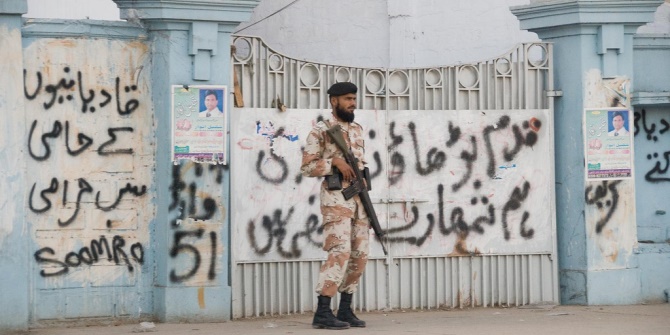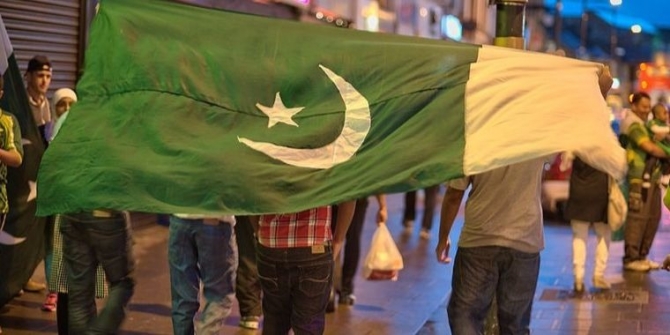 Earlier this month, an article on The Diplomat suggested that India is confronted with the choice of siding with either China or the US, or to uphold a strategy of non-alignment in the 21st century’s new Cold War. Here, Pieter-Jan Dockx argues that India has already chosen its preferred strategy. Current events such as the increased tension between Delhi and Beijing and US repositioning towards Pakistan point to India’s inclination towards the US.
Earlier this month, an article on The Diplomat suggested that India is confronted with the choice of siding with either China or the US, or to uphold a strategy of non-alignment in the 21st century’s new Cold War. Here, Pieter-Jan Dockx argues that India has already chosen its preferred strategy. Current events such as the increased tension between Delhi and Beijing and US repositioning towards Pakistan point to India’s inclination towards the US.
Tension at the border
Recent months have seen increased tension between the two rising powers in Asia. Arguably, this has the capacity to dampen relations between the countries in the foreseeable future.
As of June, there has been a standoff between the Indian Army and the People’s Liberation Army (PLA) at the Doka La pass in Doklam located at the intersection between both countries and the Kingdom of Bhutan. The Indian Army intervened to halt a PLA road construction on disputed land between China and Bhutan, close to the Indian border. While Delhi perceives the construction as Chinese aggression, Beijing considers the Indian Army’s action as an infringement of its territorial sovereignty.
According to press outlets in both countries, the standoff is deemed to be the most severe border confrontation between the two countries in over three decades, and has the potential of escalating into a full-blown military confrontation. The Chinese Communist Party-sanctioned press has warned India with references to the 1962 war in which China decisively defeated India. Indian Defence Minister, Arun Jaitley, countered these remarks by declaring that 2017’s India is different, insinuating Delhi’s preparedness for military confrontation.
The Doklam showdown is the climax of several months of tensions. In April, the Dalai Lama, Tibet’s spiritual leader currently living in exile in Himachal Pradesh, made visits to the Indian provinces of Assam and Arunachal Pradesh adjacent to China. The Tibetan leader’s visit to areas contested between both countries was firmly opposed by Beijing. As retaliation, China unilaterally renamed six places in Arunachal Pradesh to reinforce its territorial claims over the land.
In May, India refused to send a representative to China’s Belt and Road Forum, the first major summit on the global infrastructure project which has been compared to the American Marshall Plan which was rolled out in Europe after World War II. Even the United States sent an observer to the forum in Beijing, in spite of its own strained relationship with China, but India did not. Instead, it declared that initiatives like these have to be based on international standards of good governance, rule of law, transparency and openness, a clear dig at Beijing.
That very month, China also reaffirmed its refusal to grant Indian Membership to the Nuclear Supplier Group (NSG). India acquired a special waiver of the NSG in 2008, which allows the country to trade in nuclear technology. However, it has been pursuing full membership of the group on the basis that this would boost Delhi’s credibility in the eyes of possible investors. The NSG’s decision-making is based on consensus, and although a significant number of countries now support India’s participation China has consistently blocked its admission to the organisation.
Given the current tensions and the countries’ divergent foreign policy objectives, closer ties between Delhi and Beijing are therefore inconceivable at this time.
Pakistan and China’s strengthening ties
Aside from deteriorating relations between Beijing and New Delhi, American and Chinese relations with Pakistan play a pivotal role in India’s choice.
By virtue of a common aversion towards India, Islamabad and Beijing have historically enjoyed an ‘all-weather friendship’. This special relationship has recently been cemented by the China-Pakistan Economic Corridor(CPEC), the Belt and Road Initiative’s flagship project. This will lead to increased Chinese investment in Pakistan’s critical infrastructure such as railways, agriculture, pipelines and nuclear facilities.
In addition to a strengthened long-term economic partnership, defence ties between the two countries remain as strong as ever. In 2016, China agreed to provide Islamabad with eight stealth attack submarines to be delivered by 2028. Under this agreement, at a price of US $4-5 billion China is slated to offer Pakistan a long-term loan at a low interest rate. In June 2017, military leaders of both countries held talks in Beijing to discuss ways to strengthen military relations between both countries. Officials are reported to have agreed to closer cooperation in the field of weapons and equipment and anti-terrorism operations.
Waning Washington-Islamabad relations
While China-Pakistan ties are booming, another significant historical ally of Pakistan, the United States, seems to be turning its back on Islamabad, opening the door to closer ties with New Delhi.
US-Pakistan relations became tense when US officials became suspicious that Pakistan was providing safe havens to terrorist organisations such as al-Qaida and the Taliban. As a result, the Obama administration had withheld military aid assigned to the country in both 2011 and 2016. For example, in June 2016, US congress withheld funds for Islamabad’s purchase of eight F-16 fighter jets, which increased the bill from US $240 million to $700 million.
Newly elected president Donald Trump is expected to carry on this tough stance towards Pakistan. In 2012, Trump tweeted When will Pakistan apologize to us for providing safe sanctuary to Osama Bin Laden for 6 years?! Some “ally.”, an indication of his personal view of the country. Later, during his presidential campaign, he accused Pakistan of double-dealing and stated that he would request India’s help in dealing with a “semi-unstable” Pakistan.
This view came into the open during Trump’s visit to the Islamic Summit in Riyadh in May this year. As an Islamic nation, this summit was of great importance to Pakistan. However, then-Prime Minister Nawaz Sharif was not allowed to address the other Islamic leaders. Making matters worse, in his speech on Islamic terrorism, Trump mentioned India as a victim of terrorism, without identifying Pakistan as one. In addition, the American President refused PM Sharif’s request for an official meeting between both leaders, while openly holding one-on-ones with other heads of state.
Aligning with the US
Since the election of Prime Minister Narendra Modi in 2014 and Obama’s diminishing support for Pakistan, bilateral relations between Washington and Delhi have unmistakably deepened, particularly in the field of defence and security. In 2016, India received the designation of ‘major defence partner’, thus allowing the country access to US defence technology just like major US allies. This status is unique to India and institutionalises defence and technology sharing between both countries.
Although it was long unclear what ‘America First’ meant for India, the meeting between PM Modi and President Trump in June signalled strengthened friendship between both countries. In their joint statement, both leaders objected to China’s BRI project by stressing that economic projects like these need to respect sovereignty and the rule of law. This fell completely in line with India’s interpretation of the initiative, as expressed in their rationale for not attending the BRI forum.
Finding common ground in linking Islamic terrorism to Pakistan, both leaders called on the country to stop terrorists from using Pakistani territory to launch attacks in India and Afghanistan. They also demanded that perpetrators of cross-border terrorism, such as the attacks in Mumbai and Panthankot should be brought to justice by Islamabad.
Defence and security ties have also been fortified by both administrations. This month, India participated in the Malabar naval exercise in the Bay of Bengal together with the US and close American ally, Japan. With China’s growing submarine activity in the Bay, it is not a coincidence that the naval exercise was focused on anti-submarine warfare. Malabar 2017 was as a clear signal directed at Beijing.
This growing relationship between Washington and New Delhi is a calculated Indian policy, which became further evident by Narendra Modi’s changed stance towards North Korea. While India had previously been the communist regime’s third largest trade partner, Modi cut all trade ties to the country April this year. In the light of Trump’s aggressive attitude towards Pyongyang, Modi is eager to show the Americans that India is a more reliable partner than China, who continue to do business with North Korea.
As China and Pakistan’s all-weather relationship is cemented through the CPEC and tensions between Delhi and Beijing are at their peak, India seems determined to align itself with the United States. With an apparent Pakistan hawk in the White House, the stage is set for an American-Indian alliance in this century’s Cold War.
Cover image credit: aquaview CC BY-NC-SA 2.0
This article gives the views of the author, and not the position of the South Asia @ LSE blog, nor of the London School of Economics. Please read our comments policy before posting.
About the Author
 Pieter-Jan Dockx graduated from LSE with an MSc in Conflict Studies. His main research areas include Middle East and South Asian politics. Read more of his blogs at www.pieterjandockx.com.
Pieter-Jan Dockx graduated from LSE with an MSc in Conflict Studies. His main research areas include Middle East and South Asian politics. Read more of his blogs at www.pieterjandockx.com.








1 Comments